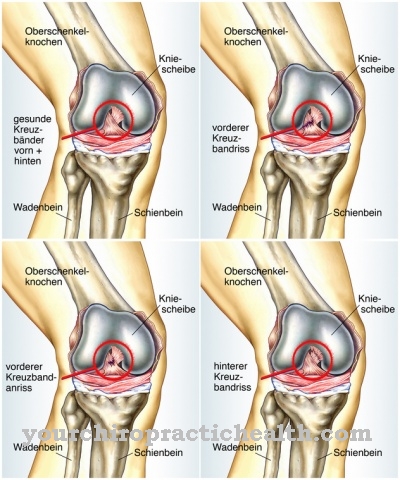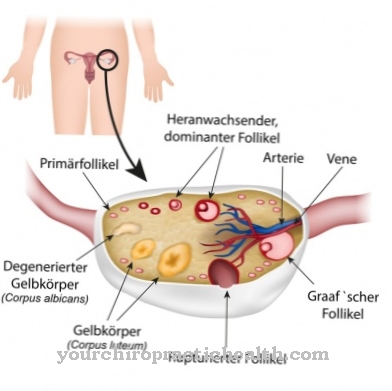As Optic chiasm is called a junction of the optic nerve. This is where the nerve fibers of the nasal halves of the retina cross.
What is the optic chiasm?
The optic chiasm is also called Optic nerve junction known and forms an important part of the visual pathway. The nerve fibers of the optic nerve (optic nerve) of both eyes cross in it. At this point, the optic nerve fibers of the medial fibers, which lie towards the nose, meet, while the outer (lateral) fibers remain on their original side.
In this way, the visual impressions that come from the left half of the face can be processed on the right half of the brain. The same procedure is reversed on the other side of the body. Whether a partial or even a complete change of fibers takes place depends on the respective vertebrate species. At the junction of the optic nerves in amphibians, both optic nerves change completely. In humans and primates, on the other hand, the proportion of intersecting fibers is around 50 percent. There is a connection between the eye position and human binocular vision.
Anatomy & structure
The optic chiasm is located in the anterior cranial fossa. There it lies in the sulcus chiasmatis of the sphenoid bone (os sphenoidale). The anterior wall and floor of the 3rd cerebral ventricle meet in this area. Below the junction of the optic nerves is the so-called Turkish saddle (Sella turcica) including the pituitary gland (pituitary gland). The pituitary stalk is located on the dorsal side.
The optic chiasm is only a partial crossover of nerve fibers. The axons (nerve cell processes), which originate from the left half of both retinas, run over the thalamus to the left half of the brain. Within the optic nerve junction, the nerve fibers of the retinal half, which is on the nasal side of the right eye, switch to the opposite side, i.e. to the left. The nerve fibers that are located in the temporal area of the left eye remain on the left side.
The opposite is true on the opposite side. This means that the axons that come from the right side of the retinas go into the right half of the brain. Within the optic chiasm, the nerve fibers change from the retinal half of the left eye, which is on the nasal side, to the right side. In contrast, the nerve fibers of the right eye facing the temple remain in their original position. The optic chiasm also forms the transition from the optic nerve to the optic tract (visual cord).
Function & tasks
The optic chiasm marks an important part of the visual pathway. Because of the partial crossover of the optic nerves from the right hemisphere of the cerebrum, only the optical impressions from the left half of the face are processed.
In contrast, the left cerebral hemisphere only processes the optical stimuli that come from the right half of the visual field. The proportion of crossing nerve fibers is optimally matched to the human field of vision. Binocular vision plays an important role here, on the one hand making the three-dimensional perception of objects possible and on the other hand ensuring the assessment of spaces and distances. From the optic chiasm, the nerve cords, which are then called the visual pathways, run towards the visual cortex of the cerebrum.
You can find your medication here
➔ Medicines for eye infectionsDiseases
The optic chiasm can be affected by various diseases. Chiasma syndrome is one of the most common health problems associated with the junction of the optic nerve. There are three characteristics that are typical. The affected people suffer from bitemporal visual field failures.
The visual impression is only missing on the outside, so that there is a view like wearing blinkers. For this reason, chiasma syndrome is also known as blinker syndrome. Furthermore, there is a reduced visual acuity, which is only noticeable on one side of the eye or on both sides. Another characteristic of the chiasma syndrome is optic atrophy, in which the nerve cells of the optic nerve are destroyed.
Chiasm syndrome is caused in most cases by masses that are often caused by tumors that form in the pituitary gland and exert pressure on the chiasm. More rarely, a melingeoma, a tumor originating from the meninges, is responsible for the development of the syndrome. Another possible cause is an aneurysm. This is a widening of the vessels that mostly affects the carotid artery, compressing the optic nerve junction, which in turn causes discomfort. Sometimes optic chiasm syndrome is caused by masses of the optic nerve.
Typical symptoms of chiasma syndrome include double vision, chronic headaches and hormonal disorders. The latter are triggered by tumors on the pituitary gland. If the mass presses on the middle area of the optic chiasm, this results in bitemporal visual field deficits. In the process, the nasal fibers of the retina are primarily compressed.
When diagnosing chiasma syndrome, changes in the sella turcica can often also be determined using x-ray examinations. If the optic nerve junction syndrome is caused by a tumor on the pituitary gland, surgery must be performed to remove it. The resulting relief causes a recovery of the field of vision and visual acuity. However, long-term damage cannot always be ruled out.
If the optic chiasm is divided on the median plane, this leads to the loss of the temporal halves of the visual field in each eye, which results in a bitemporal hemianopia. If the optic tract is severed, a homonymous hemianopia occurs, which leads to the loss of the two halves of the visual field of the eyes.
























.jpg)



